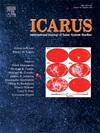The influence of spin–orbit resonances on the evolution of Mercury’s mantle and crust
IF 2.5
2区 物理与天体物理
Q2 ASTRONOMY & ASTROPHYSICS
引用次数: 0
Abstract
Mercury’s record of large impact basins and spin evolution models suggest that its present-day 3:2 spin–orbit resonance may not be primordial. It could have been established up to hundreds of millions of years after planet formation, possibly triggered by the impact that created the Caloris basin about 3.7 billion years ago. Before this, Mercury may have been in a synchronous rotation or a 2:1 resonance, which would have induced strong hemispheric surface temperature variations, influencing the thermal structure of the lithosphere and mantle.
Using 3D thermochemical mantle convection models, we simulate Mercury’s mantle evolution and volcanic crust formation over one billion years, incorporating surface temperature distributions from different spin–orbit resonances. We assess whether these variations can generate large-scale lateral differences in crustal thickness, as inferred from gravity, topography and surface composition data, and compare predicted radius changes due to mantle and core cooling with existing estimates from compressional tectonic features.
Crustal thickness, interior cooling rate, and radius change are primarily controlled by internal heat production, with models using intermediate to high heat production rates (characteristic of CI and EH chondrites) best matching observations. The mantle reference viscosity, low thermal conductivity attained at Mercury’s mantle conditions, and cooling due to melt extraction exert first-order controls on the timing of crust emplacement and its final extent. Regardless of surface temperature patterns, mantle convection is dominated by small, stable cells. While surface temperature variations influence the location of hot and cold regions at large scales, they do not alter the spatial scale of convection. Assuming vertical melt extraction, crustal thickness locally follows the convection pattern. The present-day 3:2 resonance does not induce significant large-scale variations in crustal thickness, but a past synchronous rotation could have produced hemispheric differences, with crust up to 10–15 km thicker on the dayside. Similarly, radial contraction is hemispherical, with the hot hemisphere contracting less and at a slower rate than the cold one as long as the resonance persists.
The surface record does not clearly support these hemispheric patterns. This suggests that past spin–orbit resonances may have been short lived, or that they may have affected Mercury’s interior more subtly than our models predict, or that subsequent geological processes erased or modified early large-scale asymmetries. Future high-resolution imaging and surface composition data from BepiColombo, particularly of Mercury’s poorly-mapped southern hemisphere, will be critical in testing this hypothesis and in refining the available constraints on the planet’s crustal evolution and tectonic history.
自旋轨道共振对水星地幔和地壳演化的影响
水星的大型撞击盆地记录和自旋演化模型表明,它现在的3:2自旋轨道共振可能不是原始的。它可能是在行星形成后数亿年才形成的,可能是由37亿年前形成卡洛里斯盆地的撞击引发的。在此之前,水星可能处于同步旋转或2:1共振状态,这将引起强烈的半球表面温度变化,影响岩石圈和地幔的热结构。利用三维热化学地幔对流模型,结合不同自旋轨道共振的表面温度分布,模拟了水星10亿年的地幔演化和火山地壳形成过程。根据重力、地形和地表成分数据,我们评估了这些变化是否会产生大规模的地壳厚度横向差异,并将地幔和地核冷却导致的预测半径变化与现有的挤压构造特征估算结果进行了比较。地壳厚度、内部冷却速率和半径变化主要受内部产热控制,使用中高产热速率(CI和EH球粒陨石的特征)的模型最符合观测结果。地幔参考粘度、在水星地幔条件下获得的低导热系数以及熔体萃取导致的冷却对地壳侵位的时间和最终范围起着一级控制作用。无论地表温度模式如何,地幔对流都是由小而稳定的细胞主导的。地表温度变化在大尺度上影响冷热区域的位置,但不改变对流的空间尺度。假设垂直熔融提取,地壳厚度局部服从对流模式。现在的3:2共振不会引起地壳厚度的显著大范围变化,但过去的同步旋转可能会产生半球差异,白天的地壳厚度可达10-15公里。同样,径向收缩是半球形的,只要共振持续,热半球的收缩较小,速度也比冷半球慢。地表记录并不清楚地支持这些半球模式。这表明过去的自旋轨道共振可能是短暂的,或者它们对水星内部的影响可能比我们的模型预测的更微妙,或者随后的地质过程抹去或改变了早期的大规模不对称。未来来自BepiColombo的高分辨率成像和表面成分数据,特别是关于水星南半球的地图,将对验证这一假设和完善地球地壳演化和构造历史的现有限制至关重要。
本文章由计算机程序翻译,如有差异,请以英文原文为准。
求助全文
约1分钟内获得全文
求助全文
来源期刊

Icarus
地学天文-天文与天体物理
CiteScore
6.30
自引率
18.80%
发文量
356
审稿时长
2-4 weeks
期刊介绍:
Icarus is devoted to the publication of original contributions in the field of Solar System studies. Manuscripts reporting the results of new research - observational, experimental, or theoretical - concerning the astronomy, geology, meteorology, physics, chemistry, biology, and other scientific aspects of our Solar System or extrasolar systems are welcome. The journal generally does not publish papers devoted exclusively to the Sun, the Earth, celestial mechanics, meteoritics, or astrophysics. Icarus does not publish papers that provide "improved" versions of Bode''s law, or other numerical relations, without a sound physical basis. Icarus does not publish meeting announcements or general notices. Reviews, historical papers, and manuscripts describing spacecraft instrumentation may be considered, but only with prior approval of the editor. An entire issue of the journal is occasionally devoted to a single subject, usually arising from a conference on the same topic. The language of publication is English. American or British usage is accepted, but not a mixture of these.
 求助内容:
求助内容: 应助结果提醒方式:
应助结果提醒方式:


